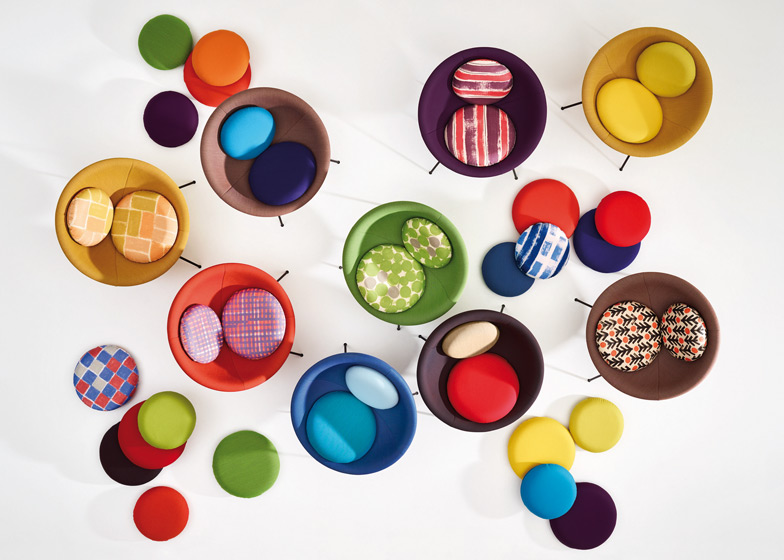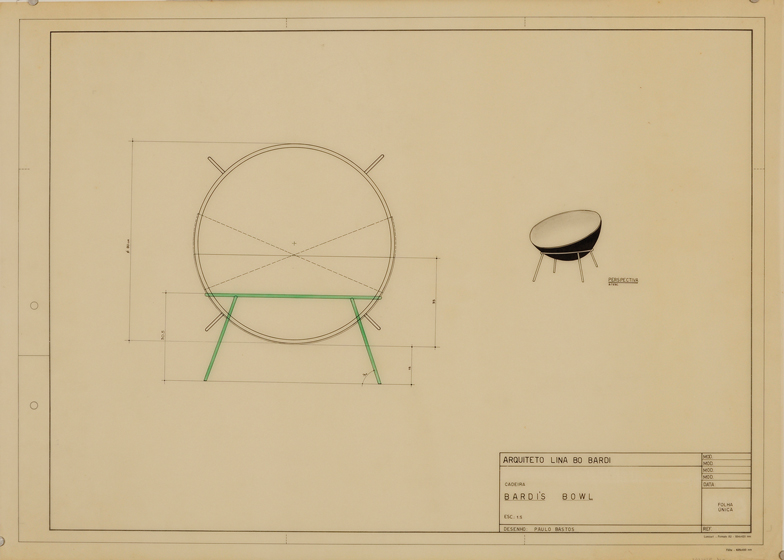Italian design brand Arper is to relaunch a limited edition version of a bowl-shaped chair designed by late Modernist architect Lina Bo Bardi in 1951 (+ slideshow).
The Bowl Chair features a metal frame with four legs supporting a ring into which the upholstered seat is inserted. The seat can be swivelled in the frame to allow for more upright or reclined seating positions, with loose cushions enhancing the design's flexibility. It will be produced in black leather and a range of coloured fabrics.
Bo Bardi, who was born in Italy in 1914 but moved to Brazil in 1946, designed the chair during a period when she was living in São Paulo and working predominantly on the design of products and interiors.
She subsequently established herself as a prominent publisher, curator and architect, responsible for important projects including the São Paulo Museum of Art and the SESC Pompeia cultural centre, also in São Paulo.
Luigi and Claudio Feltrin of Arper explained that their intention in relaunching the chair is to highlight Bo Bardi's significant legacy: "In doing this, we wish to give the Bowl Chair and Lina’s way of thinking a future. The limited edition creates a link between the past and the future."
Working with the Instituto Lina Bo and P.M. Bardi, which owns the copyright to the architect's designs, Arper developed the new chair based on Bo Bardi's sketches and a pair of original chairs from 1951 – one produced in black leather with a metal frame and the other with a transparent plastic shell and bright red cushions.
Research suggested that the production techniques specified by Bo Bardi would have relied on artisanal methods. With guidance from the Instituto, Arper identified ways to recreate the shape and comfort of the original design using modern manufacturing methods.
The chair's bowl, which was originally made from heavy hand-forged iron, is now produced in plastic to make it lighter and flexible enough to fit the foam and fabric to the frame.
Arper attempted to standardise the processes used to manufacture the chair so it can be reproduced accurately in a limited edition, embodying its designer's philosophy of combining industrialised production and individualised objects with improved interaction.
Bo Bardi's sketches show the chair and cushions in different colours and finishes that could be configured in myriad combinations and Arper is developing a broad palette of colours that reflects the influences of Italy and Brazil on Bo Bardi's oeuvre.
A single edition of the new Bowl Chair featured in the exhibition Lina Bo Bardi: Together, dedicated to the designer's life and career that was presented at the British Council in London in autumn 2012. Arper also presented the design and details of the production process at its Milan showroom during this year's Milan Furniture Fair.
An official launch event for the Lina Bo Bardi Bowl Chair will take place in London on 29 January 2014.
Since the exhibition in London there has been a resurgence in interest in Bo Bardi's work and British design brand Izé recently announced it had begun producing door handles she designed for her home in São Paulo.
Here's some more information about the relaunch of the Bowl Chair:
The Bardi's Bowl Chair manifesto
In London, 2012, the exhibition "Lina Bo Bardi: Together" imagined by the creative troika of curator Noemi Blager, filmmaker Tapio Snellman and artist Madelon Vriesendorp and sponsored by Arper celebrated not only the products but the creative practice of the Italian-born architectural free-thinker.
Why did Arper enter into partnership with the Instituto Lina Bo and P.M. Bardi to recreate and produce an edition of Lina Bo Bardi's famously iconic but never industrialized Bardi's Bowl chair? Quite simply because we share the same values and ideals: we believe in design to create meaningful dialogue.
Designed in 1951 in Bo Bardi's adopted home of Brazil, the Bowl Chair is an icon of Lina Bo Bardi's adaptive style. Balancing the worlds of industrialized fabrication and the individualized object, Bo Bardi envisioned the Bowl Chair as flexible in structure while universal and essential in form. But, as with all of Bo Bardi's designs, the ultimate emphasis remains on the human interaction with the object.
These qualities are what we aim for in every Arper collection. We appreciate the optimism and expression of everyday objects that allow us to put them to work and express our opinions and ideas at the same time.
We believe in design as an agent in conversation and conviviality, a conversation starter between form and function, a corporation and its clients or our personal reality and our ideal selves. We believe in design as an essential language to connect the past to the present and remind us what matters.
Lina believed that to standardize – to create adaptive open systems that are simple, sensual and alive – was to create potential. And we do too. And so, we introduce the Lina Bo Bardi Bowl chair.








